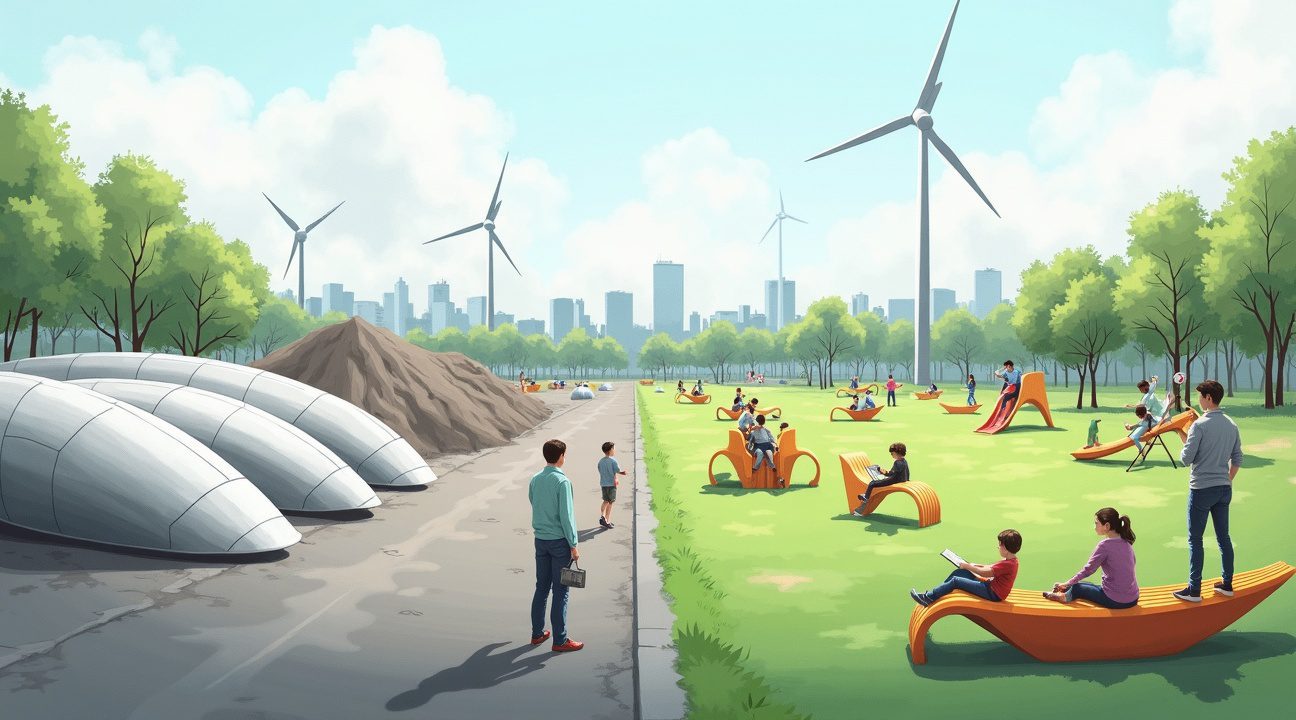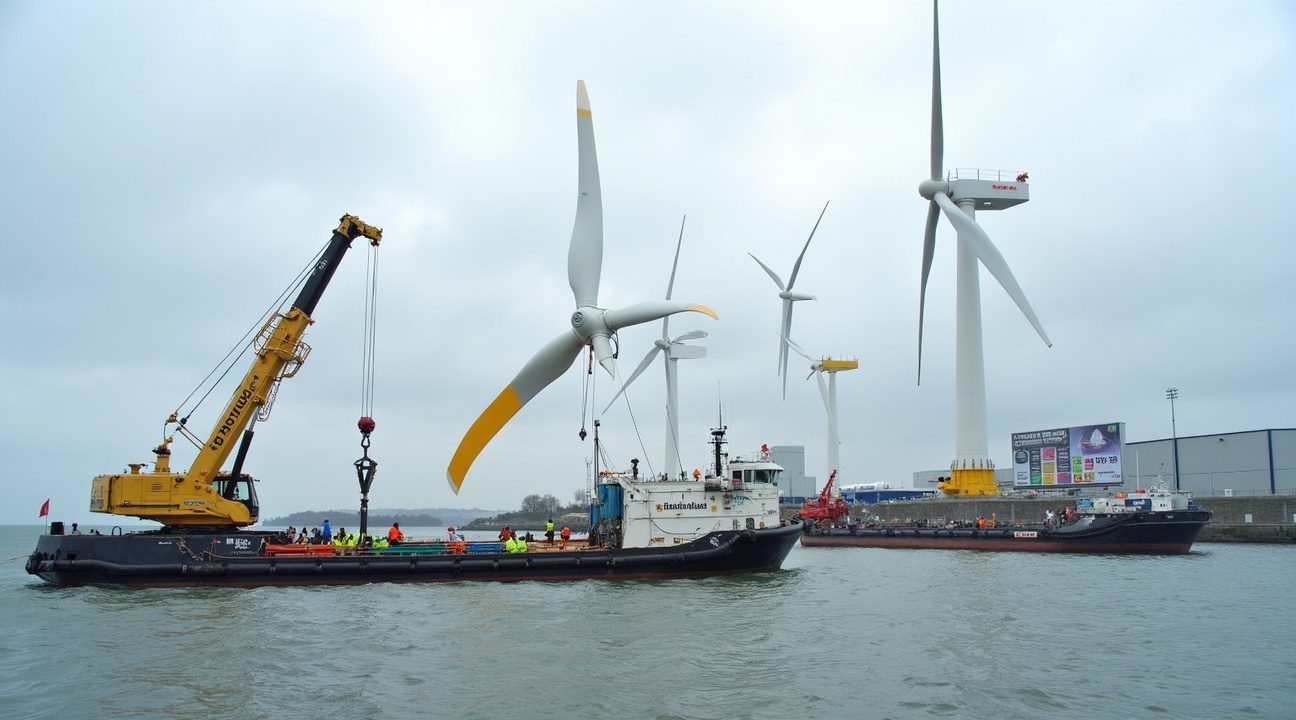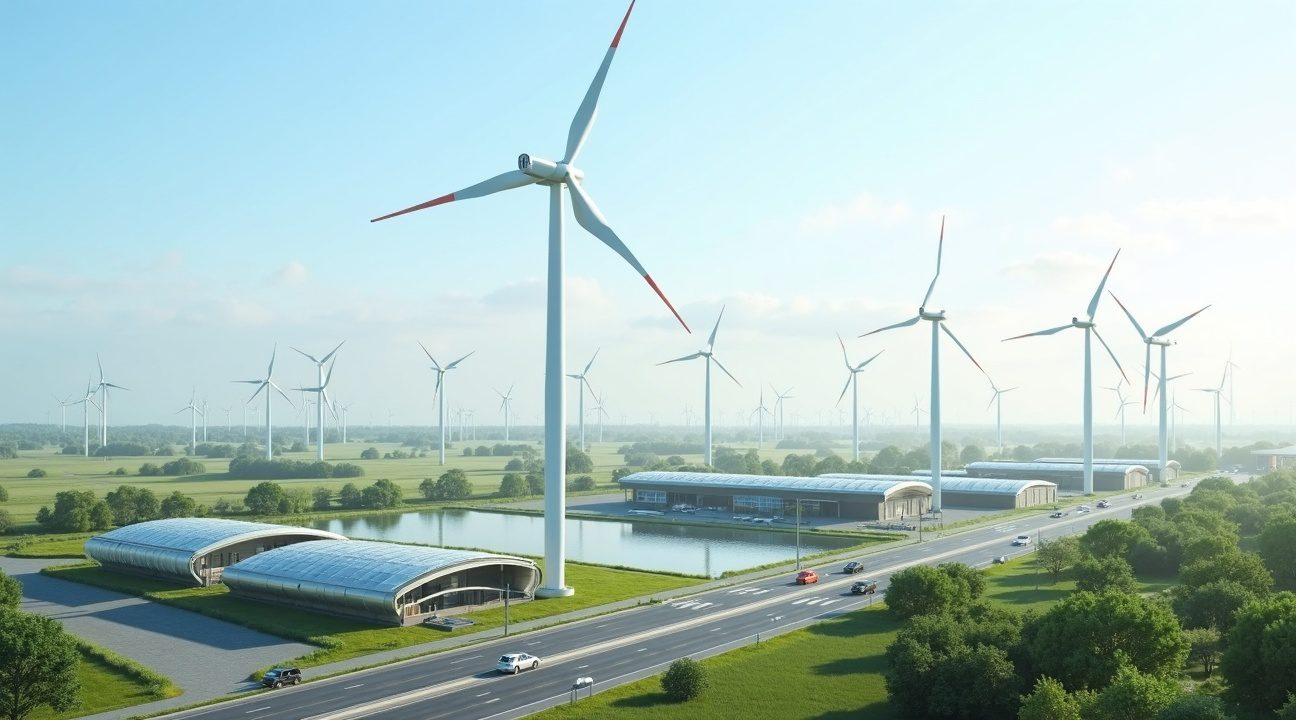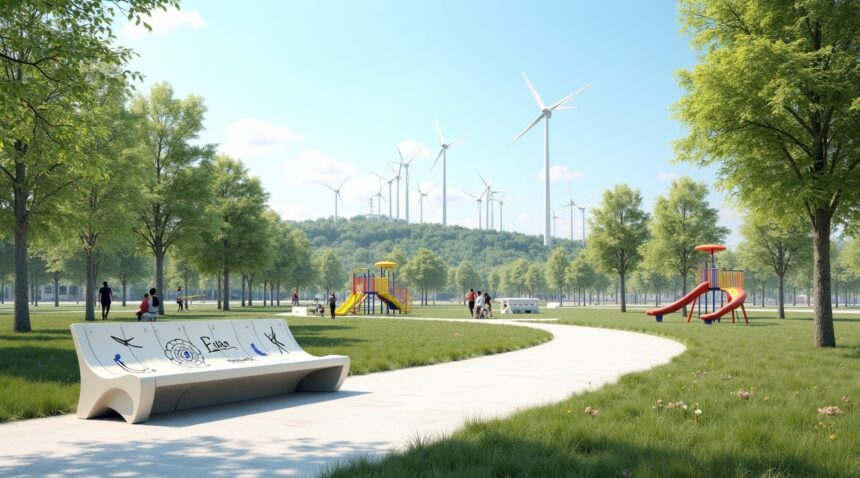Belgium leads the charge in wind turbine blade waste management by converting decommissioned blades into practical community infrastructure such as park benches and playground equipment. This innovative strategy tackles the mounting challenge of handling 40,000–60,000 tonnes of annual blade waste across Europe while delivering up to 90% carbon emission reductions compared to producing new products from raw materials.
Key Takeaways
- Environmental Impact: Converting wind turbine blades into public furniture cuts carbon emissions by up to 90% compared to manufacturing equivalent products from new materials
- Economic Viability: Belgian companies like Blade-Made manufacture repurposed products at competitive prices with conventional alternatives, eliminating financial barriers for municipal procurement
- Waste Management Solution: Belgium’s strategy redirects substantial composite waste from landfills while addressing Europe’s projected 800,000 tonnes of annual blade waste by 2050
- Regulatory Framework: Belgian law requires complete turbine removal and proper blade disposal, establishing accountability and encouraging creative reuse solutions over landfill disposal
- Industry Commitment: The Belgian wind sector aims for zero blade waste by 2030 through dedicated recycling facilities and expanding repurposing applications beyond furniture to include sound barriers and architectural elements
Belgian Company Transforms Wind Turbine Waste Into Public Furniture
Blade-Made has emerged as a pioneering force in sustainable waste management by converting decommissioned wind turbine blades into functional public furniture. Rather than sending these massive composite structures to landfills or incineration facilities, the Belgian company carefully processes them into park benches and playground equipment that serves communities across the region.
Environmental Impact and Carbon Reduction
The environmental benefits of this innovative approach are substantial. Blade-Made’s repurposing process achieves up to a 90% reduction in carbon emissions compared to manufacturing similar products from traditional virgin materials. This dramatic decrease stems from eliminating the energy-intensive production of new raw materials while simultaneously preventing blade waste from entering disposal systems that generate additional emissions.
Each transformed blade represents a significant environmental victory, as these composite materials typically contain fiberglass and carbon fiber that resist natural decomposition. By giving these materials a second life, companies like Blade-Made address both waste management challenges and resource conservation simultaneously.
Economic Viability and Market Acceptance
Cost considerations often determine whether sustainable solutions gain widespread adoption. Blade-Made’s products demonstrate remarkable market competitiveness by maintaining price parity with conventional alternatives. This cost-comparable pricing structure removes financial barriers that might otherwise prevent public procurement departments from choosing environmentally responsible options.
Urban development projects can now integrate sustainable furniture without compromising budget constraints or quality expectations. The economic viability ensures that municipalities and developers don’t face difficult choices between environmental responsibility and fiscal responsibility.
Expansion opportunities continue to multiply as the concept proves successful. The Netherlands is currently evaluating repurposed turbine blades for highway sound barriers, indicating strong potential for broader European adoption. This development suggests that Belgium’s innovation could influence infrastructure projects across neighboring countries, creating a ripple effect of sustainable practices throughout the continent.
The success of Blade-Made reflects a growing trend where circular economy principles transform industrial waste streams into valuable community resources. Their approach demonstrates how creative engineering can solve multiple problems simultaneously while creating products that enhance public spaces for generations to come.
Europe Faces Massive Wind Turbine Blade Waste Crisis
I’ve witnessed firsthand how Europe’s commitment to renewable energy has created an unexpected environmental challenge. By 2023, the continent expects to decommission 14,000 turbine blades, generating approximately 40,000–60,000 tonnes of blade waste. Belgium stands as a significant contributor to this mounting problem, with the country operating 1,234 onshore wind turbines as of April 2024.
The scale of this crisis continues to expand rapidly. Annual blade waste across Europe could surpass 50 kilotonnes by 2030, and projections suggest this figure might reach 800,000 tonnes per year by 2050. These staggering numbers reflect the natural lifecycle of wind energy infrastructure, as operators upgrade aging turbines or replace them with more efficient models.
The Technical Challenge Behind Blade Disposal
Wind energy systems present a fascinating paradox in sustainability. While 85–90% of a wind turbine’s mass can already be recycled efficiently, the blades themselves create significant disposal challenges. Their composite material structure, consisting mainly of glass fiber-reinforced polymers, resists traditional recycling methods that work well for other turbine components.
These materials were specifically engineered for durability and weather resistance, qualities that make them excellent for capturing wind energy but problematic for end-of-life processing. The same characteristics that allow blades to withstand decades of harsh weather conditions also make them nearly indestructible through conventional waste management approaches.
Belgium’s innovative response to this challenge demonstrates how creative thinking can transform environmental problems into community benefits. Rather than viewing decommissioned blades as waste, Belgian municipalities have begun converting them into functional public amenities. Park benches crafted from blade sections provide durable outdoor seating that can withstand weather conditions for decades. Playground equipment made from these materials offers children safe, long-lasting recreational facilities while keeping composite waste out of landfills.
This practical approach addresses multiple issues simultaneously:
- Communities receive high-quality public infrastructure at reduced costs.
- Waste management facilities avoid the expensive challenge of processing difficult-to-recycle materials.
- The repurposing strategy raises public awareness about renewable energy’s lifecycle.
European policymakers now recognize that addressing blade waste requires coordinated action across the renewable energy sector. Current regulations don’t adequately address the unique properties of composite blade materials, leaving operators with limited disposal options. Many blades currently end up in specialized landfills or incineration facilities, neither of which represents an optimal long-term solution.
The timing of this crisis coincides with the first generation of commercial wind farms reaching the end of their operational lives. Turbines installed during the early 2000s renewable energy boom are now being replaced with more powerful, efficient models. This replacement cycle will accelerate over the next decade, making immediate action essential for preventing overwhelming waste accumulation.
Belgium’s creative repurposing initiatives offer a model for other European nations facing similar challenges. By transforming blade waste into community assets, the approach demonstrates how circular economy principles can be applied even to materials that resist traditional recycling. This strategy buys time for researchers and manufacturers to develop more comprehensive recycling technologies while creating immediate value from what would otherwise become expensive waste.

Belgium’s Strict Laws Drive Responsible Blade Disposal
Belgian law mandates complete removal of decommissioned wind turbines, including every component from offshore installations. This comprehensive approach ensures wind turbine blades receive proper handling and prevents them from contributing to marine pollution. I’ve observed how this regulatory framework creates accountability throughout the entire lifecycle of wind energy infrastructure.
Wind farm owners bear full responsibility for decommissioning and disposal costs until blades find new purpose through sales or repurposing initiatives. Once companies like Blade-Made acquire these materials, responsibility typically transfers to the new owner. This cost structure incentivizes operators to explore creative reuse options rather than simply disposing of valuable materials.
Public Awareness Gaps Remain
Despite Belgium’s progressive legislation, public understanding of recycling requirements and associated costs remains surprisingly limited. A 2024 survey revealed Belgian residents scored an average of 7.36 out of 10 on recycling knowledge, indicating room for improvement in environmental education. Coastal residents scored even lower than the national average, which presents a particular concern given their proximity to offshore wind installations.
This knowledge gap highlights the need for enhanced public education programs about renewable energy waste management. Citizens living near wind installations should understand both the environmental benefits and disposal challenges associated with these massive structures.
Funding Challenges Limit Scaling Potential
The primary obstacle facing companies like Blade-Made isn’t technical capability but securing adequate funding for expansion. Clear policy frameworks addressing end-of-life recycling responsibility remain elusive, creating uncertainty for investors and operators alike. I’ve noticed this regulatory ambiguity makes it difficult for innovative recycling companies to plan long-term operations or attract necessary capital.
Another consideration involves the eventual disposal of repurposed products themselves. Park benches and playground equipment created from wind turbine blades will eventually reach their own end-of-life stage, requiring additional recycling solutions. This creates a cascading responsibility chain that current legislation doesn’t fully address.
Belgium’s strict removal requirements create positive environmental outcomes, but the regulatory framework needs refinement to support scaling of innovative reuse programs. Without clearer policy direction and funding mechanisms, companies struggling to transform industrial waste into community assets may find growth challenging. The success of Belgium’s circular economy approach depends on addressing these financial and regulatory gaps while maintaining environmental protection standards.

Repurposing Beats Traditional Recycling for Environmental Impact
I’ve witnessed firsthand how Belgium’s innovative approach to wind turbine blade disposal creates a stronger environmental impact than conventional recycling methods. Repurposing these massive composite structures into park benches and playground equipment directly reduces landfill waste while conserving precious raw materials, perfectly aligning with the EU’s circular economy objectives.
Traditional recycling methods like cement co-processing break down turbine blades to use minerals in cement production while organics replace coal in the manufacturing process. This method can reduce cement’s CO₂ output by up to 16% when composites make up 75% of input materials. However, direct repurposing eliminates the energy-intensive processing required for these operations, resulting in significantly lower carbon impacts overall.
Environmental Benefits of Direct Repurposing
The environmental advantages of Belgium’s repurposing strategy extend beyond simple waste reduction. Key benefits include:
- Elimination of energy-intensive shredding and processing operations
- Complete avoidance of transportation to specialized recycling facilities
- Zero need for chemical treatments or high-temperature processing
- Direct reduction in virgin material extraction for new infrastructure
- Preservation of the blade’s structural integrity for extended use
Belgium’s initiative demonstrates tangible climate action by transforming what would otherwise become waste into valuable local infrastructure. I find this approach particularly compelling because it keeps materials in their highest form of use for the longest possible time. Rather than breaking down the sophisticated composite materials that engineers specifically designed for durability and weather resistance, repurposing maintains these properties for community benefit.
The carbon footprint comparison reveals stark differences between recycling and repurposing approaches. Cement co-processing requires transportation to industrial facilities, energy for grinding operations, and integration into existing manufacturing processes. Direct repurposing involves minimal transportation distances, basic cutting and shaping operations, and immediate installation in local communities.
Belgium’s model creates a closed-loop system where wind energy infrastructure continues serving communities even after its primary function ends. This approach reduces demand for new materials in public works projects while providing durable, weather-resistant furniture and equipment that can last decades. The initiative showcases how creative thinking about waste streams can generate multiple environmental benefits simultaneously.
I’ve observed that this repurposing strategy addresses multiple sustainability challenges at once. Communities gain access to unique, durable public infrastructure while avoiding the environmental costs of manufacturing new materials. The approach reduces pressure on raw material extraction, decreases industrial processing emissions, and diverts substantial volumes of composite waste from landfills where they would persist for centuries.
The success of Belgium’s program demonstrates that direct repurposing often provides superior environmental outcomes compared to energy-intensive recycling processes. By maintaining the structural integrity and functional properties of wind turbine blades, this initiative maximizes the environmental investment already made in these sophisticated materials while creating lasting value for local communities.
Wind Industry Commits to Zero Blade Waste by 2030
The Belgian wind sector spearheads a revolutionary approach to sustainable energy infrastructure through ambitious waste elimination targets. I’ve observed how the industry actively invests in cutting-edge end-of-life solutions for turbine blades, establishing dedicated recycling facilities and innovative repurposing initiatives across the region. This comprehensive strategy positions Belgium at the forefront of achieving 100% blade recyclability or reuse by 2030.
EU-Wide Tracking and Transparency Initiatives
WindEurope’s voluntary reporting framework creates unprecedented transparency in blade decommissioning and waste diversion efforts. These tracking systems monitor progress across member states, ensuring accountability while strengthening the industry’s commitment to circular economy principles. The reporting mechanisms provide critical data that drives continuous improvement in recycling technologies and repurposing methods.
Expanding the Circular Economy Model
Blade-Made’s pioneering approach demonstrates remarkable scalability potential beyond park benches and playground equipment. The company’s innovative techniques can transform retired turbine blades into diverse infrastructure solutions, including:
- Sound barriers for highways and industrial zones
- Public shelters and transit stops
- Architectural elements for sustainable buildings
- Marine applications like breakwaters and docks
- Agricultural infrastructure such as livestock shelters
This diversification strategy reinforces circular economy principles while creating multiple revenue streams from what was previously considered waste material. The scalable model proves that sustainable practices can generate economic value while addressing environmental challenges.
Belgium’s wind industry commitment extends beyond national borders, influencing broader European policy discussions about renewable energy sustainability. I’ve noticed how this comprehensive approach attracts international attention and investment, positioning the country as a leader in sustainable energy transition. The industry’s proactive stance on blade waste management demonstrates that environmental responsibility and economic growth can coexist effectively.
The 2030 zero waste target represents more than an environmental goal—it establishes a new standard for renewable energy infrastructure management. Through continued investment in recycling technologies and creative repurposing solutions, Belgium’s wind sector transforms potential environmental liabilities into valuable community assets while maintaining its leadership in sustainable energy production.

Sources:
Blade-Made – “Belgian Company Transforms Wind Turbine Waste Into Public Furniture”
WindEurope – “Europe Faces Massive Wind Turbine Blade Waste Crisis”
Belgian Government Reports – “Belgium’s Strict Laws Drive Responsible Blade Disposal”
European Union Circular Economy Reports – “Repurposing Beats Traditional Recycling for Environmental Impact”
WindEurope – “Wind Industry Commits to Zero Blade Waste by 2030”


